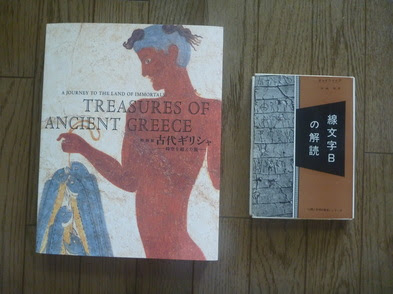The Days of Decipherment
On 20 July 2016 I went Tokyo National Museum, Ueno Park, Tokyo to see the exhibition A JOURNEY TO THE IMMORTALS: TREASURES OF ANCIENT GREECE, where I saw the linear A and B. It reminds me the youth days, so to say, the days of decipherment.
1960s -1970s is the age of decipherment in a sense. I was age 20 in 1967 and was learning language and literature at university. In 1958 John Chadwick's THE DECIPHERMENT OF LINEAR B was published from Cambridge University Press. At the preface of the book he wrote that the decipherment of linear B was told at Documents in Mycenaean Greek (Cambridge University Press, 1956) and Michael Ventris that deciphered the Linear B.
In the same age in Japan, Xixia wenzi (Xixia characters) in China was deciphered by NISHIDA Tatsuo (1928-2012) who wrote the analysis and grammar of Xixia characters through the paper Seikamoji no bunseki narabini Seikago bunpou no kenkyuu in 1962.
In almost the same time, Inca characters were studying to decipher. I frequently heard that Russian team developed largely.
In early 1970s I frequently went to Kanda, Tokyo where old bookshops were selling vast Oriental books at the Hakusan street and Yasukuni Street. I bought Chinese classics, especially linguistic classics written in the Qing dynasty and I read them almost every day containing the comparison with the western linguistic results. The Qing dynasty's heritage were DUAN Yucai, WANG Niansun, WANG Yingzhi and WANG Guowei and so forth. DUAN Yucai's Showenjezi zhu and WANG Guowei's Guantang jilin were the most important for me.
In France, 1960s was the days of Bourbaki that was one of the decipher of geometry by algebra, at least I thought so at that time. I sought and bought several Bourbaki's books at the old bookshops in Kanda, Tokyo,which is the largest old bookshop streets in Japan. But from my ability to mathematics Bourbaki was too much difficult to read on. From the days the long and winding road began to mathematics and its applicable study for language universals.
At the exhibition of ancient Greece I confirmed in particular that the stability of language was kept by letters and characters from the Linear A and Linear B.
Exhibition Catalogue numbers are the next.
39. Clay juglet c. 1800 B.C. ~ c. 1700 B.C.
40. Clay bar c. 1700 B.C. ~ c. 1650 B.C.41. Clay tablet c. 1375 B.C. ~ c. 1350 B.C.
77. Linear B bar and tablet c. the 13th century B.C.
The numbers 39 and 40 are Linear A. 41,
77 are Linear B.
77 are Linear B.
For my part the stability has been one of the biggest themes on language phenomena since I was taught from CHINO Eiichi through the results of the Linguistic Circle of Prague, especially of Sergej Karcevskij.
The exhibition catalogue and Chadwick's book Japanese translated edition.
Reference
References 2
References 3
- Meaning Minimum On Roman Jakobson, Sergej Karcevskij and CHINO Eiichi
- Half Farewell to the Linguistic Circle of Prague and Sergej Karcevskij
- Sergej Karcevskij, Soul of Language
- Gift from Sergej Karcevskij
- Follower of Sergej Karcevskij
- For KARCEVSKIJ Sergej
- Notes for KARCEVSKIJ Sergej / Note for KARCEVSKIJ Sergej's "Du dualisme asymetrique du signe linguistique"
References 5
- The Time of Language, Ode to The Early Bourbaki To Grothendieck
- Bourbaki' ELEMENTS DE MATHEMATIUE Troisieme edition, 1964
Tokyo
30 July 2016
Sekinan Library
Read more: https://srfl-paper.webnode.com/news/the-days-of-decipherment/

